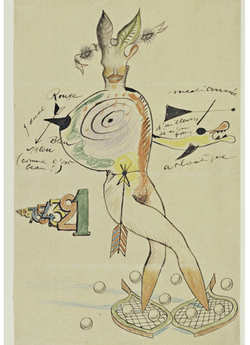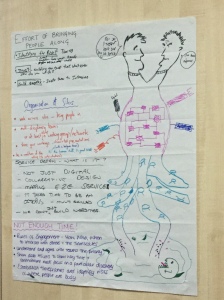The title of this post could actually apply to any situation where grabbing a Sharpie or a board marker provides more insight than just talking. Which in my experience is pretty much all situations!
However, this is specifically about a game I’ve developed that helps people to share the things that get in the way of doing great work, and to come up with some practical suggestions for how to overcome them. The instructions for the game are included below.

Along the way I’ve accidentally channelled Freud, tapped the Surrealists, and shown rooms full of conference delegates pictures of naked creatures with tennis racquets for feet. (It turns out this is actually quite tame compared to the things produced by the delegates themselves – examples at the bottom of the post!)
I first experimented on the obliging folk at UX Bristol 2016, and then played it again with the rather more international crowd at Service Design in Government 2017. Both groups really went for it, and people asked me to share the format so they can try it on their unsuspecting colleagues. This is for them, and for you too if you’d like to have a go.
Childish beginnings
The idea originally came from the game of paper consequences I played when I was a child – the one where you take it in turns to draw parts of a body and end up with something cute and innocent like this cat produced by US school children.
Then I discovered it was also something the Surrealists did when they were exploring their subconscious, under the influence of Freud. They called them Cadavre Exquis (Exquisite Corpses)… which is clearly a totally appropriate thing to adapt and try at a conference, right?
I went for it, and this is the version we played.
Setting up
The game is best played by small groups of people sitting at shared tables, 4-6 people per table is good. You can have as many tables as you like, but it’s ideal to have 4 or 8 tables so that everyone has a go at each part of the body.
Each table needs a sheet of flip chart paper, some post-its and enough pens for one per person, preferably in a range of colours. You may also want some blue-tak to create a gallery at the end.
What’s stopping you?
You need to agree 4 common blockers to work on. The first time we played we only had 60 mins so I crowd-sourced a few themes on Twitter in advance, stuck them up on the wall, and asked the participants to vote for their top 4. The second time we had 90 mins, so we sourced the themes from the room.
 Each participant takes a few minutes to think about what stops them doing the work they want to be doing (e.g. great service design). They write one blocker per post-it, and add these to a wall where clusters of similar post-its should start to emerge. Once you have some clear themes give them snappy titles and ask everyone to vote for their top 3. You can do this with stickers, or just ask people to mark them with their pen. You can then pick the 4 themes with the most votes.
Each participant takes a few minutes to think about what stops them doing the work they want to be doing (e.g. great service design). They write one blocker per post-it, and add these to a wall where clusters of similar post-its should start to emerge. Once you have some clear themes give them snappy titles and ask everyone to vote for their top 3. You can do this with stickers, or just ask people to mark them with their pen. You can then pick the 4 themes with the most votes.
(If you’re interested, the 4 themes at UKBristol were: 1. People thinking UX just means design 2. The “business” adding things that don’t help the user 3. The opinions/preconceptions of colleagues 4. Not enough time. At SDinGov they were: 1. The effort of bringing people along with you 2. Organisational silos 3. Confusion around what “service design” means 4. Not enough time.)
Get ready to play!
Before you start each table needs to fold their sheet of paper in half from top to bottom, and in half again, so that they have four equally spaced horizontal strips across the sheet.
These are then the instructions…
- Write the first blocker top left of the top strip
- Does this sound familiar? What does it feel like? Discuss around the table for 5 mins
- Someone who fancies having a go at drawing captures the conversation – using a head. This needs to fill the right hand part of the strip, and you need to leave a bit of neck sticking out over the fold
- What might help in this situation? Discuss around the table for 5 mins (this is the really valuable part, so you can taken longer on it if there’s time)
- Capture the main suggestions as bullet points, next to the picture
- FOLD! Pass it on to the next table…
Repeat the above 3 more times – drawing a body & arms for blocker number 2, legs for blocker 3 and feet for blocker 4. Someone needs to be strict on timings and keep things moving along.
At the end of the last round you can unfold and admire your work!
Where do you go from here?

It’s good to stick your creatures up on a wall and have a chat about what you see.
Are there some similarities? (e.g. when we looked at “The effort of bringing people along” at SDinGov two of the groups had drawn two headed creatures, so we could talk about why that was).
What suggestions stand out? What are you actually going to take away and do differently?
Regardless of what gets taken back to the day job everyone involved is likely to have benefitted from an opportunity to get things off their chest, to realise they are not alone, and that there are things they can do to unblock their work.
These are in fact rather similar to the benefits of running an agile Retrospective… but with more two-headed creatures and tennis-racquet shoes.


[…] Original source – Make it quotidian […]